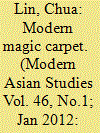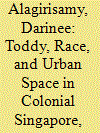|
|
|
Sort Order |
|
|
|
Items / Page
|
|
|
|
|
|
|
| Srl | Item |
| 1 |
ID:
173384


|
|
|
|
|
| Summary/Abstract |
While Sir Thomas Stamford Raffles led the expedition that founded colonial Singapore in 1819 and conceptualised many of the early institutions that developed the trade port, it was the depiction and commemoration of his time in the region that made him an icon of imperial mythology. This was part of a process in which admiration of his name and exploits were exalted, ultimately representing a core element in the Victorian mentality, the need to create heroes to glorify the British Empire. This article will survey and analyse how the commemoration of Raffles in the first 75 years of colonial rule, through the commissioning of statues and the attachment of his name to establishments and institutions, solidified and justified a British presence in the region and larger imperial history, which continues to echo in the modern nation-state of Singapore and its history.
|
|
|
|
|
|
|
|
|
|
|
|
|
|
|
|
| 2 |
ID:
118902


|
|
|
|
|
| Publication |
2012.
|
| Summary/Abstract |
Wireless radio broadcasting in colonial Singapore began with amateur organizations in the early 1920s, followed by commercial ventures and, finally, the establishment of a monopoly state broadcasting station. Listeners followed local broadcasting as well as international short wave radio. Both participants in and the content of radio reflected the multiracial, cosmopolitan make-up of a colonial port city which functioned through the lingua franca of English. The manner in which early broadcasting developed in Singapore sheds light on the creation of different imagined communities and the development of civil society. There was an increasing presence of non-Europeans, women, and youth, many of whom were drawn by the mystique of this new technology. Wireless radio also brought about a transformation in the public soundscape. These themes contribute to our understanding of the global history of radio as well as the nature of colonial societies within the British empire.
|
|
|
|
|
|
|
|
|
|
|
|
|
|
|
|
| 3 |
ID:
167939


|
|
|
|
|
| Summary/Abstract |
British Malaya's toddy industry features in history as a problem that plagued the plantation economy, when the city toddy shop was no less important in contributing to a racialized discourse of modernity in Singapore. Although colonial policy served to engender the racialization of toddy drinking as a peculiarly Tamil vice, toddy's social life in Singapore demonstrates that it became the poor man's beer regardless of race. The alcoholic drink gave rise to new adaptations, enterprises, and innovations in colonial Singapore, thus carving out a unique place for itself in the city's cultural landscape. Yet, Singapore's toddy industry dominated the public spotlight for less palatable reasons, which rendered it the subject of numerous demands for increased government regulation. The colonial government responded with a slew of measures that often differed from the federation's toddy policy. Singapore's toddy industry yielded divergent imaginaries of modernity, particularly in the aftermath of the Second World War. Some reformers sought its abolition or relocation away from city spaces, whilst others demanded its modernization on the grounds that this meagre establishment was the labourer's sole source of recreation. In light of recent developments that have prompted the government's intervention in limiting migrant labourers’ access to alcohol, this article will examine the considerations that informed the colonial establishment's urban toddy policy and its corresponding impact on Singapore society as it sped towards decolonization. Through an exploration of toddy's treatment in the English-language press, oral histories, and colonial office records, this article seeks to contribute perspectives on an aspect of Singapore's social history that remains largely unexplored.
|
|
|
|
|
|
|
|
|
|
|
|
|
|
|
|
| 4 |
ID:
142506


|
|
|
|
|
| Summary/Abstract |
From the mid-1920s, Indian music scenes developed in Singapore that were not just about the construction of regional and religious forms of Indian diasporic belonging. Drawing upon European, Chinese and Malay influences (musical and otherwise), and performing in contexts that were uncommon in India, Singaporean Indian musicians contributed to non-Indian musics, while incorporating non-Indian influences into Indian genres. Such musical–communal interactions functioned in colonial Singapore to locate the island as a hub for the constitution of a ‘Malayan Indian sonic geography’. By encouraging links between various Indian and other communities throughout the peninsula via radio, films, recordings, touring networks, and performances at hotels and amusement parks, music became a means for Indian communication and integration in colonial Malaya — a sonic geography that would be significantly transformed, though not eliminated, after Singapore and Malaysia parted ways in 1965.
|
|
|
|
|
|
|
|
|
|
|
|
|
|
|
|
|
|
|
|
|